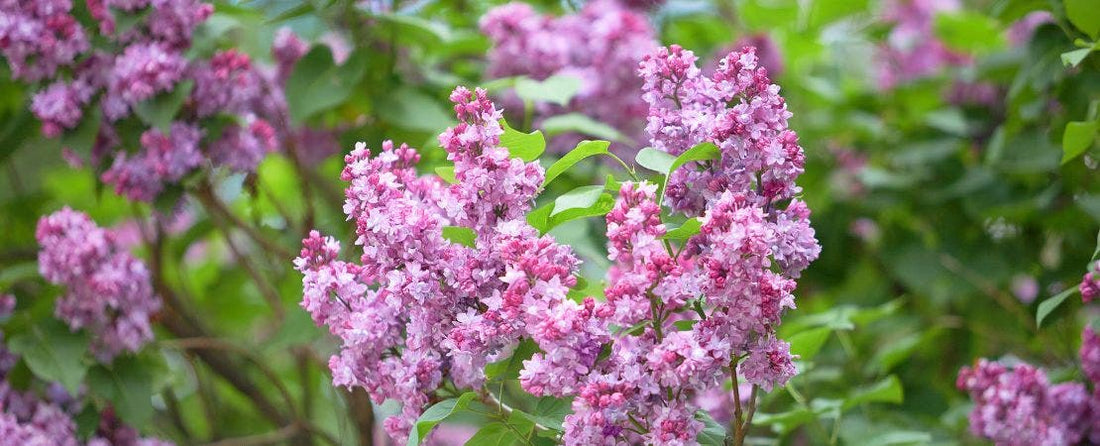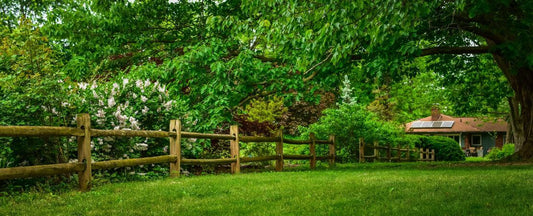Reasons You should Grow Lilacs

Why Would You Want to Grow Lilacs? Well, Why Wouldn’t You?
The lilac is an easy-to-grow, attractive shrub with big clusters of sweet-smelling flowers in the spring. Lilac bushes have been grown in the United States since before the Revolution and make regular appearances in American literature, from the poetry of Walt Whitman and Amy Lowell to the novels of Louisa May Alcott, Martha Hall Kelly, and Jane Kirkpatrick, Kate Chopin’s short story, and many more. I’ve grown lilacs most of my life.
The classical lilac is the common lilac, Syringa vulgaris, in the olive family, Oleaceae. The olive family includes olives (Olea), privet (Ligustrum), and ash (Fraxinus). Syringa is the Latin word for pan pipes (the musical instrument) because lilac stems were carved into pipes. In Latin, vulgaris means common—you can see where English got the word vulgar. There are thirteen species in the lilac genus Syringa, native across Eurasia. At least eight species and their hybrids are available commercially. This article is mainly about the common lilac.
While Syringa is the scientific name for lilacs, syringa is the common name of at least two other plants, Melia azedarach (family Meliaceae), of South Africa, also called the Indian or Persian lilac, and Philadelphus lewisii (mock orange). Neither of these is closely related to lilacs.
The name lilac is shared as well; other plants reminded people of lilacs. These plants include the Indian lilac mentioned above, California lilac Ceanothus species, (buckthorn family Rhamnaceae), New Zealand lilac, Hebe hulkeana (plantain family, Plantaginaceae), purple lilac vine or native lilac (of Australia), Hardenbergia violacea (pea family, Fabaceae), and two called summer lilac, Buddleja davidii (figwort family, Scrophulariaceae) more often called butterfly bush, and Hesperis matronalis (cabbage family, Brassicaceae), known to me as dame’s rocket. Mostly they have numerous purple flowers like lilacs.
Common lilac is a deciduous shrub that grows 6-20’ tall with a spread of 6-12’. The plants sucker, so old plants often form multi-stemmed clumps. Lilacs flower in middle to late spring. Flowers are 1/4 to 1/2” in diameter, with four or five petals, in loose branched clusters (panicles) of dozens of flowers. The flowers of most varieties are strongly fragrant. Blossoms can be white, blue, lilac, purple, purple-red, or a combination of colors. The leaves are round to heart-shaped, deep green, 4” to 6” across.
Growing Lilacs
One’s first lilac is generally planted from a bare root, or as a small plant in a pot. Bare root plants should be transplanted in the early spring; potted plants can be transplanted from midspring to early fall. To plant, dig a hole big enough to spread out the roots, set the plant in the hole, and refill the hole with soil rich in organic matter. Water thoroughly. Once established, which can take up to three years, lilacs are drought tolerant, although deep watering is a good idea during long hot periods. Lilacs bloom better with plenty of nutrients, which can be provided by mulching with compost or other organics or applying 5-10-5 fertilizer in the spring.
Planting in the right spot is important. Lilacs do best in full sun and need six hours of sun, daily, to flower well. They prefer neutral to alkaline soils and well-drained locations. Lilacs are susceptible to powdery mildew, which turns leaf surfaces white, and lilac bacterial blight, which turns leaf tips black. Both pathogens thrive in still air and humidity, so plant the lilac far enough from other plants, fences, and buildings that air moves freely around it.
Where to Plant Lilacs
Lilacs are generally a northern shrub. They are hardy to USDA Zones 3-7. In areas warmer than Zone 7, they flower poorly because a period of cold (vernalization) is required for flower production. This is particularly true for the common lilac; other species and hybrids are more tolerant of a warm winter, but generally less tolerant of a severe winter. Both south and north, check the hardiness of the particular plant before buying.
Use lilacs for a casual hedge, as a privacy screen, or as a backdrop. Spectacular in bloom, they are a nice solid green the rest of the growing season. One by itself will form a robust small tree that can be a spring focal point when it is covered in blossoms. I am wary of recommending them as a focus in the front yard because in my area, powdery mildew is common on lilacs in late summer. However, my varieties are old; newer varieties are less likely to develop mildew. All lilac varieties bloom for a few weeks, so a grouping of several varieties will extend flowering.
How to Choose Lilacs
There are hundreds of varieties of lilac today. The first characteristic to look for in a variety is hardiness in your area. Then consider double vs single flowers, flower, and bud color, whether they bloom early or late, and whether the blooming period is long (for a lilac). Some newer cultivars, hybrids of a reblooming Chinese species, will flower again in fall. Look also at disease resistance if powdery mildew or lilac bacterial blight are common in your area.
Caring for Lilacs
Established lilacs need little care. Avoid over-watering them. There is no need to remove the old flowers. They contain seeds which birds like. Nevertheless, many sources recommend trimming off the old flowers. That should be done cautiously, because the buds for next year form right below the old flowers. Pruning too deeply will destroy next spring’s flowers.
Lilacs are, however, quite resilient to pruning. Old plants can be rejuvenated by cutting them off at the ground (at 18”) in late winter; new, more vigorous shoots will come up from the base of the plant. Late winter pruned plants will set buds the next fall and flower again after a year. A method for rejuvenating an old plant without losing a year of blooms is to cut 1/3 of the plant back to almost the ground annually for three years. At the end of the third year, the whole plant will have young shoots, but it will have flowered each year.
Some lilacs are grafts, especially named cultivars. These have shoots with better flowers growing on hardier root stocks. If your lilac is grafted or might be, prune to rejuvenate cautiously because if the upper plant is not robustly healthy, the shoots that come up after pruning might be from the root, not the graft, and have quite different flowers.
Lilacs sucker, forming groves. Cut off the suckers for a neater, tree-like plant. If you like the plant, and it is not grafted, transplant suckers, once they develop good roots, for more plants. Likewise, lilacs can be rooted from cuttings or by layering.
4 reasons to plant lilacs: easy-to-grow, attractive shrub, lovely flowers, sweet-smelling.
Bonus reasons: minimal care, no deadheading.
History of Lilac Bushes
Wild lilacs, like cultivated lilacs, have beautiful fragrant flowers, so people noticed them. Not many of the plants of Greece appear in their mythology, but lilacs do. According to the myth, Syrinx was a beautiful nymph who rejected all offers of marriage. Pan, God of shepherds, pastures, and forests, fell madly in love and would not take “no” for an answer. She fled until she reached a river too wide to cross, where she begged the nymphs of the river for protection. Pan arrived and embraced her, but found he was hugging a bush. Syrinx had changed into a lilac. Pan wailed in distress, and the lilac branches made a sympathetic sound. Intrigued, he cut branches and glued them together with wax, producing the first pan pipe (shepherd’s pipe). This myth provides a romantic story explaining why lilacs are called Syringa.
Lilac, our English name for the plant, was borrowed from the French, lilac, which is the same as the Spanish and Arabic names, from the Persian, līlak, a variant of nīlac, “bluish,” originally derived from nīl “blue” or “indigo” in Sanskrit. What I like is that from being named after a color in Persian, the plant’s name, lilac, became the word for a color in English; lilac is a pinkish purple.
Despite being native to Greece and the Balkans, lilacs were unknown in northern Europe through the Middle Ages. In the 1500s, European ambassadors in Constantinople saw them in the Ottoman emperor’s palace gardens and brought cuttings home. Lilacs were planted across Europe and carried to North America. Planted in New Hampshire in 1750, the lilac is their state flower. George Washington planted lilacs at Mount Vernon in 1792. Settlers took lilacs all over North America; you can find big old plants growing at remote homesteads in the Midwest.
Lilac flowers are attractive to bees and butterflies. As non-native shrubs, few native insects feed on them.
Lilac folklore is confusing. They are the flower of the 8th wedding anniversary and yet were a funeral flower and considered unlucky to bring indoors. Furthermore, using lilacs for wedding anniversaries and funerals strikes me as difficult, because lilacs flower in a pulse in the spring. Only a few funerals or weddings take place while lilacs are available. In general, lilacs represent beauty and hardiness, but also, with their short flowering time, life’s brevity.
Lilac scent is common in cosmetics and perfumes, but those scents are artificial, because extracting scents from the flowers is difficult at industrial scale. The leaves are astringent and can be made into a face wash, as can the flowers. Otherwise, it is rarely mentioned medically. You can dye cloth with lilac flowers, leaves, and twigs, but few dye books include lilac; apparently it makes a poor dye. Lilacs shoots not only carve into pan pipes, but older wood makes spoons, small bowls, and the like, if you are handy with a knife.
Finally, lilac flowers are edible. Toss them into salads or desserts as garnish. The scent lingers; they are wonderful! Or treat them like other edible flowers, candy or fry them, for example.
Lots to enjoy with a lilac!
Written by Kathy Keeler, A Wandering Botanist


